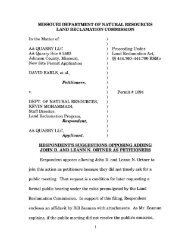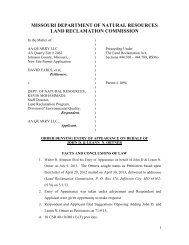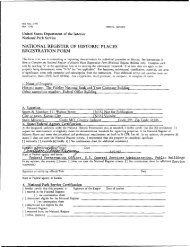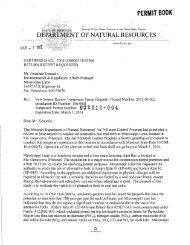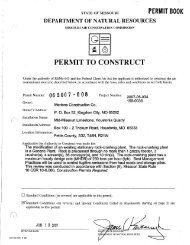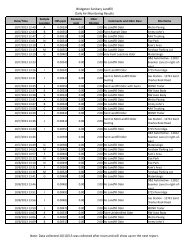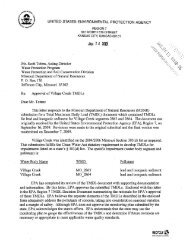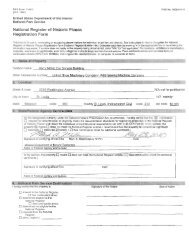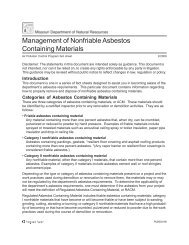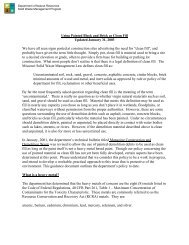Winter 2006 - Missouri Department of Natural Resources
Winter 2006 - Missouri Department of Natural Resources
Winter 2006 - Missouri Department of Natural Resources
Create successful ePaper yourself
Turn your PDF publications into a flip-book with our unique Google optimized e-Paper software.
y John Drew and Karen Rouse<br />
“Water is the scarcest and most important<br />
resource in the western United States.”<br />
– Bob Stallman, president <strong>of</strong> the American Farm Bureau Federation<br />
S tallman captured the<br />
Western view on<br />
water at a congres-<br />
tion for <strong>Missouri</strong> River water will intensify.<br />
“The <strong>Department</strong> <strong>of</strong> <strong>Natural</strong><br />
<strong>Resources</strong> is responsible for protectsional<br />
hearing entitled, “Water: Is it ing not only the state’s water quality,<br />
the Oil <strong>of</strong> the 21st Century?” Mis- but also water quantity,” said Mike<br />
souri, in competition for water, finds Wells, deputy department director and<br />
itself at a strategic crossroads where chief <strong>of</strong> Water <strong>Resources</strong>. “As de-<br />
east meets west.<br />
mand escalates and the supply dimin-<br />
For several decades the <strong>Missouri</strong> ishes, we need to ensure that future<br />
<strong>Department</strong> <strong>of</strong> <strong>Natural</strong> <strong>Resources</strong> has generations have adequate access to<br />
been at the heart <strong>of</strong> the battle over the river’s resources.”<br />
water in the <strong>Missouri</strong> River. There are In the first half <strong>of</strong> the 20th century,<br />
10 states and 28 Indian tribes in the tremendous floods wreaked havoc on<br />
<strong>Missouri</strong> River basin; the states and farms and cities along the <strong>Missouri</strong><br />
tribes are sovereign entities, with River, taking a heavy toll on human<br />
competing interests in the water. The lives and personal property. Congress<br />
state <strong>of</strong> <strong>Missouri</strong>, located along its responded by passing the 1944 Flood<br />
southern reach, is the last to use water Control Act whereby five mainstem<br />
from the <strong>Missouri</strong> River before it en- dams would be constructed to curtail<br />
ters the Mississippi River at a point flooding along the <strong>Missouri</strong> River. Al-<br />
not far upstream from St. Louis. though Fort Peck Dam in Montana<br />
According to the U.S. Geological was already built by this time, it<br />
Survey, <strong>Missouri</strong> River Basin users would be included with the other five<br />
already consume an estimated 28 per- dams to form the <strong>Missouri</strong> River<br />
cent <strong>of</strong> the total water available. As Mainstem Reservoir System. The sys-<br />
demands for water increase and more tem is operated by the U.S. Army<br />
projects are developed, the competi- Corps <strong>of</strong> Engineers (Corps) and has<br />
two primary purposes set by Congress:<br />
flood control and navigation.<br />
Secondary authorized purposes include<br />
water supply, power generation,<br />
fish and wildlife protection, irrigation<br />
and recreation.<br />
The <strong>Missouri</strong> River reservoirs constitute<br />
the largest reservoir system in<br />
North America. At the normal water<br />
level they store approximately 55<br />
times the amount <strong>of</strong> water that is<br />
stored in the Harry S Truman Reservoir,<br />
the largest reservoir in <strong>Missouri</strong>.<br />
The reservoir system is primarily<br />
fed by snowpack from the Rocky<br />
Mountains, and snows that fall on the<br />
northern Great Plains.<br />
Like a bank account, the reservoirs<br />
are used to store water in times <strong>of</strong> excess<br />
to reduce flooding and to release<br />
water in times <strong>of</strong> shortage. In an average<br />
year, the water stored in the spring<br />
provides ample water for all uses,<br />
without drawing water from the reservoirs’<br />
“account.” In high-run<strong>of</strong>f years<br />
like 1995 and 1997, excess water had<br />
to be released for much <strong>of</strong> the year to<br />
<strong>Winter</strong> <strong>2006</strong> 9<br />
DNR photo by Scott Myers



